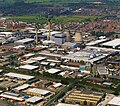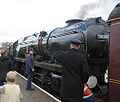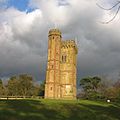The South East England Portal

South East England is one of the nine official regions of England in the United Kingdom at the first level of ITL for statistical purposes. It consists of the nine counties of Berkshire, Buckinghamshire, East Sussex, Hampshire, the Isle of Wight, Kent, Oxfordshire, Surrey and West Sussex. Cities and towns in the region include Aldershot, Ashford, Aylesbury, Basingstoke, Bracknell, Brighton and Hove, Canterbury, Chichester, Crawley, Eastbourne, Farnborough, Gosport, Guildford, Hastings, High Wycombe, Margate, Maidstone, Medway, Milton Keynes, Newport, Oxford, Portsmouth, Ramsgate, Reading, Slough, Southampton, Winchester, Woking and Worthing.
South East England is the third-largest region of England, with a land area of 19,072 square kilometres (7,364 sq mi), and is also the most populous with a total population of 9,379,833 in 2022. The region contains eight legally chartered cities: Brighton and Hove, Canterbury, Chichester, Milton Keynes, Oxford, Portsmouth, Southampton and Winchester. The region's close proximity to London has led to South East England becoming a prosperous economic hub with the largest economy of any region in the UK, after London. The region is home to Gatwick Airport, the UK's second-busiest airport, and Heathrow Airport (the UK's busiest airport) is located adjacent to the region's boundary with Greater London. The coastline along the English Channel provides numerous ferry crossings to mainland Europe.
The region is known for its countryside, which includes two national parks: the New Forest and the South Downs, as well as the North Downs, the Chiltern Hills and part of the Cotswolds. The River Thames flows through the region and its basin is known as the Thames Valley. It is also the location of a number of internationally known places of interest, such as HMS Victory in Portsmouth, Cliveden in Buckinghamshire, Thorpe Park and RHS Wisley in Surrey, Blenheim Palace in Oxfordshire, Windsor Castle in Berkshire, Leeds Castle, the White Cliffs of Dover and Canterbury Cathedral in Kent, Brighton Palace Pier, and Hammerwood Park in East Sussex, and Wakehurst Place in West Sussex. The region has many universities; the University of Oxford is the oldest in the English-speaking world, and ranked among the best in the world.
South East England is host to various sporting events, including the annual Henley Royal Regatta, Royal Ascot and The Derby, and sporting venues include Wentworth Golf Club and Brands Hatch. Some of the events of the 2012 Summer Olympics were held in the south east, including the rowing at Eton Dorney and part of the cycling road race in the Surrey Hills.
In medieval times, South East England included much of the Kingdom of Wessex, which was the precursor to the modern state of England. Winchester was the capital of England after unification of the various states, including the kingdoms of Kent, Sussex and Mercia. Winchester stopped being the administrative capital of England some time in the 13th century as its influence waned while the City of London dominated commerce. The last monarch to be crowned at Winchester was Richard II in 1377, although the last monarch to be crowned by the Bishop of Winchester was Queen Mary I in 1553. (Full article...)
Selected article
Netley Abbey is a ruined late medieval monastery in the village of Netley near Southampton in Hampshire, England. The abbey was founded in 1239 as a house for monks of the austere Cistercian order. Despite royal patronage, Netley was never rich, produced no influential scholars nor churchmen, and its nearly 300-year history was quiet. The monks were best known to their neighbours for the generous hospitality they offered to travellers on land and sea.
In 1536, Netley Abbey was seized by Henry VIII of England during the Dissolution of the Monasteries and the buildings granted to William Paulet, a wealthy Tudor politician, who converted them into a mansion. The abbey was used as a country house until the beginning of the eighteenth century, after which it was abandoned and partially demolished for building materials. Subsequently the ruins became a tourist attraction, and provided inspiration to poets and artists of the Romantic movement. In the early twentieth century the site was given to the nation, and it is now a Scheduled Ancient Monument, cared for by English Heritage. The extensive remains consist of the church, cloister buildings, abbot's house, and fragments of the post-Dissolution mansion. Netley Abbey is one of the best preserved medieval Cistercian monasteries in southern England. (Full article...)
Selected pictures
Selected biography
Edward Michael "Bear" Grylls OBE (/ˈɡrɪlz/; born 7 June 1974) is a British adventurer, writer, television presenter and former SAS trooper who is also a survival expert. He first drew attention after embarking on a number of notable adventures, including several world records in hostile environments, and then became widely known for his television series Man vs. Wild (2006–2011). He is also involved in a number of wilderness survival television series in the UK and US, such as Running Wild with Bear Grylls and The Island with Bear Grylls. In July 2009, Grylls was appointed as The Scout Association’s youngest-ever Chief Scout of the United Kingdom and Overseas Territories at the age of 35, a post he has held for a second term since 2015 and in 2024 became the second longest serving Chief Scout after Robert Baden-Powell. On 5 September 2024, Grylls was succeeded as Chief Scout by Dwayne Fields. (Full article...)
On This Day in South East England
3 October:
- 1970: The wedding of John Major (born in Carshalton, Surrey) to Norma took place. John became Prime Minister of the United Kingdom in 1990.
- 1978: Footballer Neil Clement was born in Reading, Berkshire.
- 2015: Former Secretary of State for Defence and Chancellor of the Exchequer Denis Healey died in Alfriston, East Sussex
Categories
Related portals
WikiProjects
Topics
Associated Wikimedia
The following Wikimedia Foundation sister projects provide more on this subject:
-
Commons
Free media repository -
Wikibooks
Free textbooks and manuals -
Wikidata
Free knowledge base -
Wikinews
Free-content news -
Wikiquote
Collection of quotations -
Wikisource
Free-content library -
Wikiversity
Free learning tools -
Wikivoyage
Free travel guide -
Wiktionary
Dictionary and thesaurus























![Image 25 Credit: Michael Wilmore The Kent & East Sussex Railway was opened by Colonel H.F. Stephens, the railway engineer, in 1900. At its fullest extent, it ran nearly 22 miles[35km] from Robertsbridge on the Tonbridge to Hastings main line to Headcorn on the main line between Tonbridge and Ashford, Kent. More about the Kent & East Sussex Railway... (from Portal:Kent/Selected pictures)](http://up.wiki.x.io/wikipedia/commons/thumb/2/2f/KentAndEastSussexRailway%28MichaelWilmore%29Oct2005.jpg/120px-KentAndEastSussexRailway%28MichaelWilmore%29Oct2005.jpg)








































































































